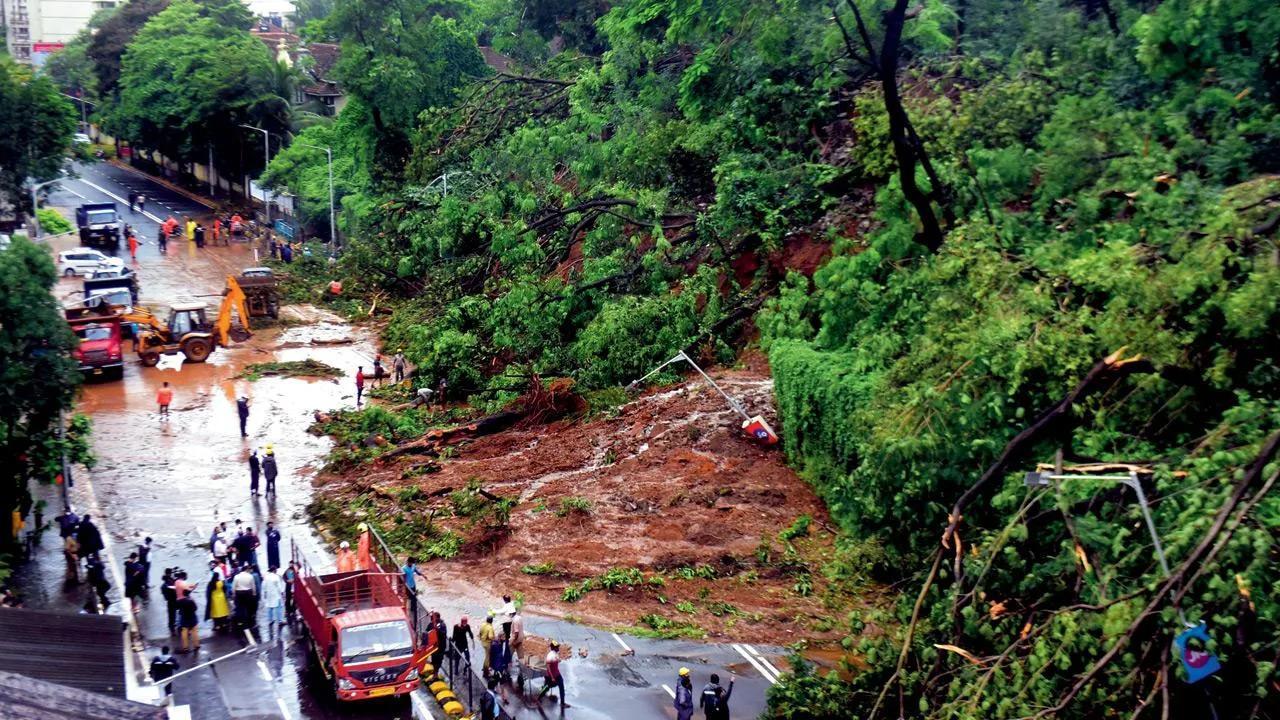Apart from lightning that registered the highest number of deaths, it was flooding that was responsible for maximum deaths in the country

The landslide that took place near Kemps Corner in July last year. File pic
In 2021, extreme weather events accounted for maximum deaths in central part of India, from Maharashtra, Odisha, and Madhya Pradesh, India Meteorological Department (IMD) Director General, Meteorology, Mrutyunjay Mohapatra said on Wednesday. Apart from lightning that registered the highest number of deaths, it was flooding that was responsible for maximum deaths in the country.
ADVERTISEMENT
"In the year 2021, the extreme weather events accounted for the maximum number of deaths in Maharashtra, Odisha and Madhya Pradesh and the largest number of districts that were affected were in Madhya Pradesh, Maharashtra, and Uttar Pradesh," Mohapatra said here during his virtual presentation at a media conclave, the Anil Agarwal Dialogue 2022, organised by the Centre for Science and Environment (CSE). The number of very heavy and extremely heavy rainfall events in the month of June and July were higher in 2021 compared to previous year.
In June, there were 277 incidences of very heavy rainfall (between 115.6 mm and 204.5 mm) in 2021 compared to 262 in 2020 and 211 in 2019 while there were 35 incidences of extremely heavy rainfall (more than 204.5 mm) in 2021 compared to 36 in 2020 and 52 in 2019. Similarly, in July, there were 121 incidents of extremely heavy rainfall in 2021 compared to 90 in 2020 and 161 in 2019, the IMD data showed.
Western Ghats were especially vulnerable in the entire country when it came to receiving heavy and extremely heavy rainfall. Heavy rainfall and flood-related incidents reportedly claimed 750 lives, he said, adding, however, lightning and thunderstorms took 780 lives. At a session on the subject of extreme weather events and climate change, Down to Earth's Akshit Sangomla pointed out salient points from the Intergovernmental Panel on Climate Change's (IPCC) Sixth Assessment Report released two days ago. The Earth's average surface temperature rise will cross 1.5 degrees Celsius in the next 20 years, and 2 degrees Celsius by the middle of the century if there is no drastic reduction in GHG emissions.
"Even if emissions are brought to net-zero by the middle of the 21st century, there will be an 'overshoot' of the 1.5 degrees Celsius limit by 0.1 degrees Celsius. A scary forecast is that the Arctic is likely to become sea-ice free in September -- the peak summer month -- at least once before 2050," he pointed out.
Professor of Environmental Sciences at the Jawaharlal Nehru University, A.P. Dimri echoed the dire warnings. "Glaciers are depleting and increasing the flow of rivers in north India. The northern sides of the country will receive more rain compared to the eastern side. Cloudburst is becoming common, and we have found that in case of a cloudburst along the foothills of the Himalayas, the precipitation goes up by 14 per cent."
Before the session, CSE Director General, Sunita Narain had rung the alarm bell too. "The latest IPCC report has made it clear that the world has a small window to act to reverse the damage -- climate change impacts are devastating; half the world's population is highly vulnerable to the catastrophic changes; and this will get worse, much worse."
This story has been sourced from a third party syndicated feed, agencies. Mid-day accepts no responsibility or liability for its dependability, trustworthiness, reliability and data of the text. Mid-day management/mid-day.com reserves the sole right to alter, delete or remove (without notice) the content in its absolute discretion for any reason whatsoever
 Subscribe today by clicking the link and stay updated with the latest news!" Click here!
Subscribe today by clicking the link and stay updated with the latest news!" Click here!







